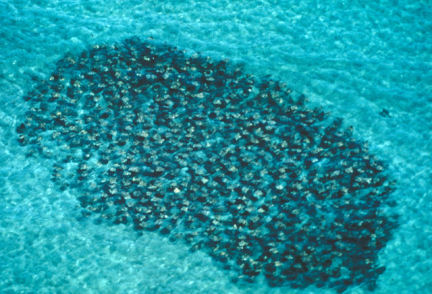Food web woes
If sharks disappeared from the oceans, rays might thrive, but shellfish would probably suffer.
By Emily Sohn
Sharks are scary—no doubt about it. Just ask anyone who’s seen Jaws or other films that feature these sharp-toothed creatures.
But there’s something that might be just as scary as meeting up with a shark—at least from an environmental perspective. It’s the thought of what might happen if sharks disappeared from the oceans. That’s because sharks are important players in delicate food webs, suggests a new study out of Canada.
Fishing companies have been killing large sharks for decades. Sometimes they’ve done it on purpose, and sometimes they’ve done it by mistake. Because of these kills, the animals that sharks eat have boomed. And that’s bad news for the creatures even lower on the food web.
Along the East Coast of the United States, only sharks that are at least 2 meters (6.6 feet) long are tough enough to eat a lot of the medium-size sharks, rays, and skates living in those waters. Eleven large shark species in the region fit into that category.
Researchers led by Ransom Myers in Nova Scotia reviewed 17 surveys that counted big sharks and their prey during the past 35 years. They found that numbers of all 11 species have dropped since 1972.
As the big sharks disappear, most of the smaller sharks, rays, and skates have increased in number. Surveys have shown increases in 12 of 14 species of these sea creatures over the past 30 years. The populations of some of these species are 10 times as high as they were three decades ago.
 |
|
Cownose rays travel in a dense horde. Each fall, such hordes from the bays of the New Jersey and Delaware region swim south along the coast for the winter.
|
| W.S. Otwell |
Researcher Charles H. Peterson recently heard fishermen in North Carolina complaining that cownose rays were eating up all the region’s bay scallops. He and his colleagues at the University of North Carolina’s Institute of Marine Sciences at Morehead City decided to test whether this was really happening.
To keep rays from eating scallops in certain areas, the scientists put a protective ring of poles around the scallops. Rays are wider than most sea creatures and won’t usually swim between poles that are spaced closely together. (The rays could turn sideways and fit through, but they don’t usually do this.) Other animals, however, swim easily through the gaps between poles.
In 2002 and 2003, at the beginning of the fall season, researchers found populations of bay scallops that were healthy and dense. But after rays migrated through, the scallops nearly disappeared in areas that were not surrounded by poles. Within protected areas, only half of the scallops were gone. It’s not even certain that the missing ones got eaten, Peterson says, since they might just have swum away.
The study suggests that efforts to replace declining populations of shellfish, such as scallops and oysters, might require extra levels of protection against predators.
The findings reinforce the message from a 1998 study of a food web in Alaska. In that area, killer whales can normally eat otters. Otters eat sea urchins. And sea urchins eat kelp. When the whales ate more otters, the study found, sea urchins thrived, and the kelp suffered.
In food webs, balance is key.
Going Deeper:
Milius, Susan. 2007. Too few jaws: Shark declines let rays overgraze scallops. Science News 171(March 31):197. Available at http://www.sciencenews.org/articles/20070331/fob5.asp .
Sohn, Emily. 2003. Swimming with sharks and stingrays. Science News for Kids (Sept. 17). Available at http://www.sciencenewsforkids.org/articles/20030917/Feature1.asp .







